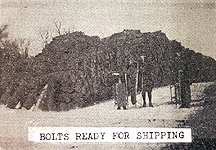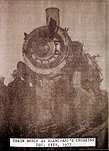|
Soon after the
railroad was put through Cobban, a man by the name of George Hatch saw
the need of a siding, or spur about two and one-half miles north of
Cobban. From there, the shipping of logs bolts, cattle, pickles and
other goods were loaded out on rails, either on or in the railroad cars,
and transferred to their destination. I though my memory was telling me
that I recall a Water Tank there for filling the locomotive, but here
again by checking this out I was told that what I remembered was a
pickle tank on legs. W.G. & H.P. This all burned down in the early
1930's. Pickles were a dependable crop for extra money for several
years, during the twenties. The Spur was built in 1904. A log buyer from
the Cadott area by the name of Tilden bought the timber in that area.
W.G Louie Blanchard contracted to furnish the logs to Mr. Hatch for
loading from this Spur. Bob LeMay recalls shipping some cattle out of
that Spur also, possibly the last one to use it. The Station was a short
lived adventure. It was nearly abandoned in the late 1920's. I recall
the long handled water pump for pumping water from the Spring into the
pickle tank. The train crew would stop occasionally to pump water into their
locomotive when they were getting low on water. The main water tank was
in Holcombe. By the time the service from Cornell to Holcombe was
discontinued (1943), the Diesel locomotive was in use, so no longer was
a water tank needed.
The Ed LeMay farm was just north and west of Hatch's
Spur. Ed was an old logger by trade, although his logging was in the far
north Chippewa County and Rusk County, he was well known in the Cobban
area.
Also, close to Hatch's Spur was the large farm to the
east. This farm was owned by Mr. Cohen. I believe he was the owner of
the Cohen Store in Cornell. There is not much left of this farm now, but
in those years it was quite a big operation.
Courtesy of Emil Gerber
from the book "Memories of Cobban".
|

|

|
| A picture of a section car. Bill
Schultz is 2nd from right
Courtesy of Emil Gerber |
8 foot bolts ready for shipping
behind the three local children. Scenes like this were very common
in Wisconsin over the last century.
Courtesy of Emil Gerber |
|

|

|
| Bill Schultz and John Chapek with a
couple of other gentlemen at a double Spur. Judging by the lack
of structures and the time taken, this may have been taken at
Hatch's Spur.
Courtesy of Emil Gerber
|
Another view of some Gandy Dancers
at work near a Spur that may have been Hatch's Spur.
Courtesy of Emil Gerber
|
Train Wreck at Blanchard's Crossing
dated December 11, 1937
From the Chippewa Falls Newspaper, December 11, 1937
Milton Garland of Spooner, Engineer, lay near death with a fractured scull in St. Joseph's hospital
today as a result of a train wreck about four miles south of Cornell on the Omaha Railroad tracks where an engine and seen cars left the track and practically were demolished. Guy McCall, also
of Spooner, and the fireman were also seriously injured but expected to live.
The accident occurred about 10:40 this morning when the combination freight and passenger train was traveling north towards Cornell. The engine was traveling backwards and pulling the cars. The tank or oil car was leading the train. It is believed by some of the men on the train that the tank car was rocking back and forth and finally left the track, pulling the engine with it.
Sees leaving tracks
Guy McCall, Fireman, while laying in the passenger coach on the end of the train suffering from a broken shoulder and numerous cuts and bruises, stated that he had just finished firing the engine when the accident happened. He said that he had just put his shovel back in the coal car, straightened up just in time to see the tank car leaving the rails. From that point on, he remembered nothing else.
The engine was turned completely around and lay diagonally across the track on one side with it's nose pointed north. The tank car having left the
roadbed entirely and was strewn all over the landscape for 100 feet beyond the engine. Four box cars also left the track and all of them were standing upright. They were smashed together and
severely damaged. Three others left the track and were also badly damaged. The passenger coach and two other box cars remained on the rails.
The accident happened just after the train had passed Blanchards crossing, some of the men stating that the track might have possible been heaved up by the frost causing the tank car to leave the rails. The two men riding in the engine were thrown clear of the wreck and lay about thirty feet from the engine when they were picked up. Garland was rushed to St. Joseph's hospital where physicians state that the may not live. McCall was also taken to the hospital.
A wrecking crew was expected to take over the scene this afternoon. No estimate of the damage was made to the press today, but it is expected to run into four or more figures.
R. A. Larson, Nat Cyr of Chippewa Falls, the conductor, and L. J. Tandberg of Rice Lake were the other members of the train crew, but escaped injuries as they were riding in the rear coach. Nat Cyr, conductor, stated that they were going between 18 to 20 miles an hour at the time of the crash, and that the extreme weight and pressure of the loaded cars
continued to pile op the train.
No passengers were riding on the train, but several other railroad employees are said to have been on the train heading north toward their homes.
Milton Garland, age 54, died shortly afterwards at 1:00 am from severe head injuries from striking frozen ground. Guy McCall, age 44, escaped death due to this accident. Milton was
survived by his wife and three children, two sons and one daughter. He was
laid to rest in Spooner.
|

|

|
| The box cars and at least one ore
car remained upright during the wreck. amazingly so did the
one coach that was part of the train.
Courtesy of Emil Gerber |
Another ore car had the trucks
removed by the impact.
Courtesy of Emil Gerber |
|

|

|
| Some of the workers clearing the
tracks after the wreck. Ten wheeler 329 has the cab, piping, and
catwalks missing. |
The locomotive involved in the
wreck was number 329, a 4-6-0 I-1 class typically using tender
number 1372. |
|


























